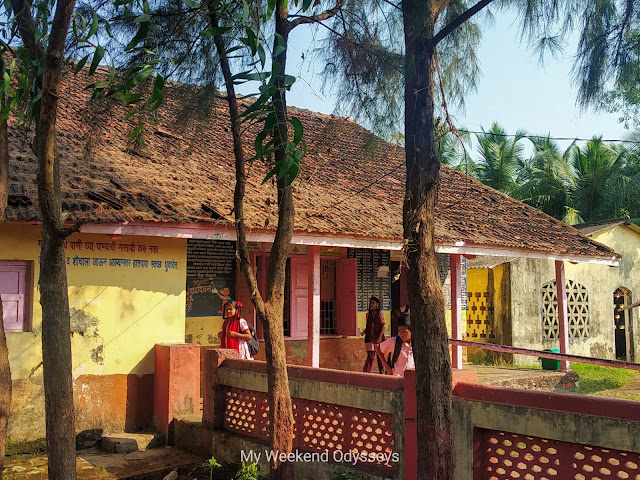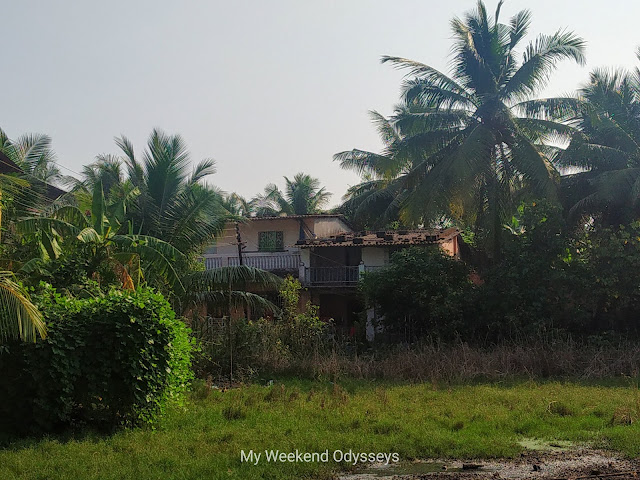Exploring the estuarine island in middle of Vasai creek - Panju island
Panju island is a small piece of green land with some houses in the middle of Vasai creek which one gets a glimpse of while passing by on a local train or when traveling on the western line towards Gujarat. This piece of land lies between Bhayander and Naigaon station on the western line of Mumbai's local rail network. Panju island is an estuarine island in Vasai creek accessible by a small boat ride from Naigaon jetty, This is the only way to enter the island. When I first read about it briefly in some article published in a newspaper, I was quite intrigued by the story about its heritage and the contribution of this village to the Indian freedom struggle. It was on my bucket list for two years which I finally had a chance to visit recently.
Panju is an ancient village, It is said that legendary Maratha commander Chimaji Appa, younger brother of Peshwa Bajirao used to carry out monetary transactions from this island. He had wrested control of Vasai fort from the Portuguese. The island lies on the south side of Vasai fort and ramparts of the fort can be seen from here. Even in India's freedom struggle, the island has given 21 freedom fighters, the highest in Thane district and this was when the village population was just 300 people.
The interesting thing about the island is it has zero pollution for there are no cars on the island, It has the best statistics with regards to sex-ratio and newer generations have 100 percent literacy. The village is predominantly inhabited by the farming community of Aagris who was once involved in salt pan works on the island as well as sand dredging and fishing. But with a ban on sand dredging, villagers have taken jobs outside the village.
As one lands on the island after a small boat ride from Naigaon what welcomes us is a monument displaying names of 21 freedom fighters from the village. The Vasai Pragati co-op credit branch proudly displays its board that "It is a fully computerized branch". It is the only bank branch on the island.
The streets here are so narrow that one can pass stuff from one house to another without having to step out of the house. Few houses display old construction like stone walls and display the characteristic arch windows and doors but most of the village houses are new constructions now.
While exploring the streets of the village, one noticeable thing was villagers ever smiling and welcoming faces.
One of the villagers I talked to was more than happy to share information on life in the village today. The village got piped water only in 1983, before that small village pond was used for daily water needs from ancient times. When the village population grew, water was brought in huge cans by local trains passing over an old British-era bridge that touched the island. The motormen would halt for an unofficial stop for few seconds when water cans would be unloaded from the train. The British-era bridge can still be seen though it is abandoned today. Today they have sufficient water supply supplied by municipal bodies through water pipes.
The village only got electricity supply in 1989, 42 years after independence. There is a monument erected near an old Hanuman temple compound that displays the date when the foundation was laid to bring electricity to the village. The water supply and electricity were possible mainly due to the village sarpanch for 37 years who toiled hard to get these infrastructures to the island village.
Another interesting thing about the village is, it is situated on a height above sea level hence irrespective of heavy rains and flooding that may occur in mainland Mumbai. The village has never got flooded, rainwater drains easily in the creek.
The village has an old Hanuman temple and secondary school where village kids study till 10th std. Another villager whom I met in the temple was kind enough to give me a tour of the temple which housed a doctor dispensary and a community hall on the first floor. The old temple structure has been extended to include the newer addition. An old stone smeared in vermilion lies in the temple sanctum which was worshiped from ancient times.
Beyond the Hanuman temple lies few bigger houses with their own gardens which are used to grow different vegetables, for their own consumption as well as to be sold in the market. We were invited to see one of these home gardens by a village lady who gave us a brief about different vegetables and flowering plants in her garden. One unique flowering plant in her garden was called the "Lal Komda" flower due to its resemblance to the male hen's comb.
There is another smaller shrine outside the village on the way to the village pond. The idol was not that of any god or a goddess but an old wooden shaft covered in a cloth. Probably it was a shrine of "gram devta" or "village god".
A village pond is a place where the village ladies still come to wash their clothes and gossip. An ancient round stone lay near the pond. Beyond this point, there is a huge land parcel some portion of which is farming land, some salt pans while remaining is covered with mangroves and hardy forest. The villager I met earlier had informed me that there is a proposal to start agro tourism to attract visitors and also connect the island to the Bhayander suburb by constructing another jetty.
Panju is a true cradle of nature. A self-sufficient and zero pollution island close to the city of Mumbai. The island has a lot of potentials to be developed into a tourist spot maintaining a fine balance with nature. Being an estuarine island in the creek it also attracts birds during winters. If one wants to get a peep into the islander's way of life, This is a perfect weekend destination.
How to reach: Shared ricks are available from Naigaon station which charges Rs 9 for one way ride to the Jetty. There is only one old boat that chugs between Naigaon jetty and the island from 6 am to 10 pm. The boat ride is only for 10 minutes and charges Rs 10 for the return ride.
How to reach: Shared ricks are available from Naigaon station which charges Rs 9 for one way ride to the Jetty. There is only one old boat that chugs between Naigaon jetty and the island from 6 am to 10 pm. The boat ride is only for 10 minutes and charges Rs 10 for the return ride.










































Comments
Post a Comment